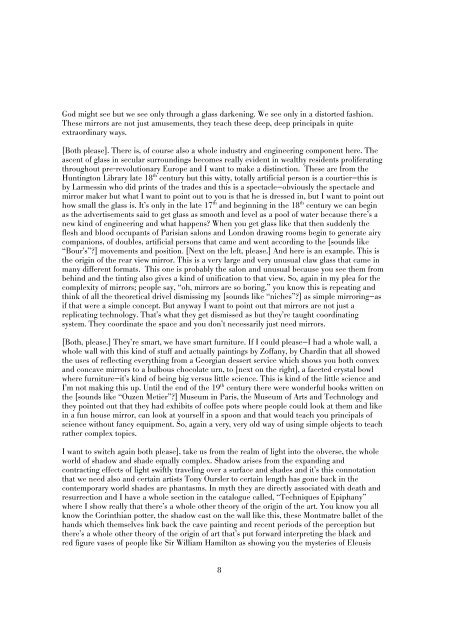SECTION 1 - via - School of Visual Arts
SECTION 1 - via - School of Visual Arts
SECTION 1 - via - School of Visual Arts
You also want an ePaper? Increase the reach of your titles
YUMPU automatically turns print PDFs into web optimized ePapers that Google loves.
God might see but we see only through a glass darkening. We see only in a distorted fashion.<br />
These mirrors are not just amusements, they teach these deep, deep principals in quite<br />
extraordinary ways.<br />
[Both please]. There is, <strong>of</strong> course also a whole industry and engineering component here. The<br />
ascent <strong>of</strong> glass in secular surroundings becomes really evident in wealthy residents proliferating<br />
throughout pre-revolutionary Europe and I want to make a distinction. These are from the<br />
Huntington Library late 18 th century but this witty, totally artificial person is a courtier—this is<br />
by Larmessin who did prints <strong>of</strong> the trades and this is a spectacle—obviously the spectacle and<br />
mirror maker but what I want to point out to you is that he is dressed in, but I want to point out<br />
how small the glass is. It’s only in the late 17 th and beginning in the 18 th century we can begin<br />
as the advertisements said to get glass as smooth and level as a pool <strong>of</strong> water because there’s a<br />
new kind <strong>of</strong> engineering and what happens? When you get glass like that then suddenly the<br />
flesh and blood occupants <strong>of</strong> Parisian salons and London drawing rooms begin to generate airy<br />
companions, <strong>of</strong> doubles, artificial persons that came and went according to the [sounds like<br />
“Bour’s”?] movements and position. [Next on the left, please.] And here is an example. This is<br />
the origin <strong>of</strong> the rear view mirror. This is a very large and very unusual claw glass that came in<br />
many different formats. This one is probably the salon and unusual because you see them from<br />
behind and the tinting also gives a kind <strong>of</strong> unification to that view. So, again in my plea for the<br />
complexity <strong>of</strong> mirrors; people say, “oh, mirrors are so boring,” you know this is repeating and<br />
think <strong>of</strong> all the theoretical drivel dismissing my [sounds like “niches”?] as simple mirroring—as<br />
if that were a simple concept. But anyway I want to point out that mirrors are not just a<br />
replicating technology. That’s what they get dismissed as but they’re taught coordinating<br />
system. They coordinate the space and you don’t necessarily just need mirrors.<br />
[Both, please.] They’re smart, we have smart furniture. If I could please—I had a whole wall, a<br />
whole wall with this kind <strong>of</strong> stuff and actually paintings by Z<strong>of</strong>fany, by Chardin that all showed<br />
the uses <strong>of</strong> reflecting everything from a Georgian dessert service which shows you both convex<br />
and concave mirrors to a bulbous chocolate urn, to [next on the right], a faceted crystal bowl<br />
where furniture—it’s kind <strong>of</strong> being big versus little science. This is kind <strong>of</strong> the little science and<br />
I’m not making this up. Until the end <strong>of</strong> the 19 th century there were wonderful books written on<br />
the [sounds like “Ouzen Metier”?] Museum in Paris, the Museum <strong>of</strong> <strong>Arts</strong> and Technology and<br />
they pointed out that they had exhibits <strong>of</strong> c<strong>of</strong>fee pots where people could look at them and like<br />
in a fun house mirror, can look at yourself in a spoon and that would teach you principals <strong>of</strong><br />
science without fancy equipment. So, again a very, very old way <strong>of</strong> using simple objects to teach<br />
rather complex topics.<br />
I want to switch again both please], take us from the realm <strong>of</strong> light into the obverse, the whole<br />
world <strong>of</strong> shadow and shade equally complex. Shadow arises from the expanding and<br />
contracting effects <strong>of</strong> light swiftly traveling over a surface and shades and it’s this connotation<br />
that we need also and certain artists Tony Oursler to certain length has gone back in the<br />
contemporary world shades are phantasms. In myth they are directly associated with death and<br />
resurrection and I have a whole section in the catalogue called, “Techniques <strong>of</strong> Epiphany”<br />
where I show really that there’s a whole other theory <strong>of</strong> the origin <strong>of</strong> the art. You know you all<br />
know the Corinthian potter, the shadow cast on the wall like this, these Montmatre ballet <strong>of</strong> the<br />
hands which themselves link back the cave painting and recent periods <strong>of</strong> the perception but<br />
there’s a whole other theory <strong>of</strong> the origin <strong>of</strong> art that’s put forward interpreting the black and<br />
red figure vases <strong>of</strong> people like Sir William Hamilton as showing you the mysteries <strong>of</strong> Eleusis<br />
8








